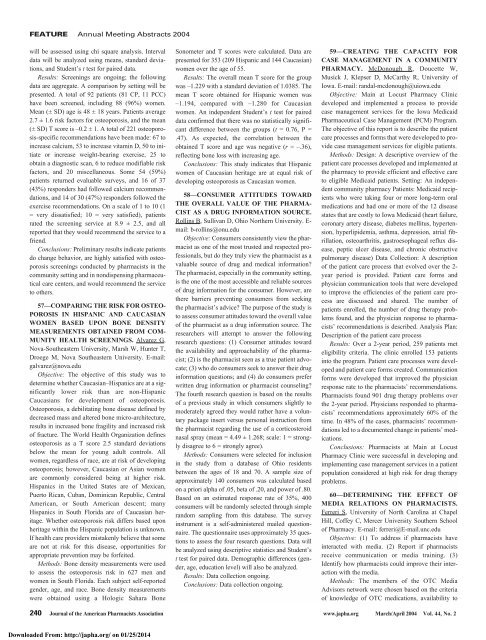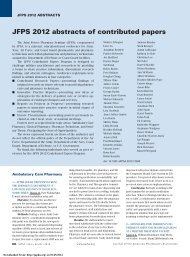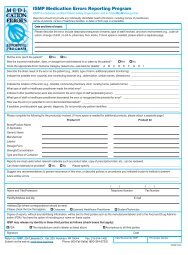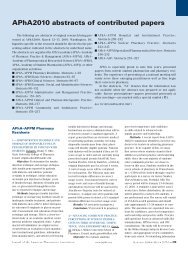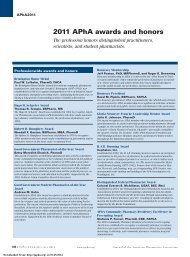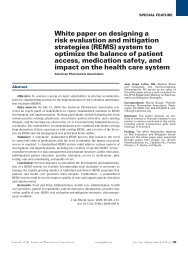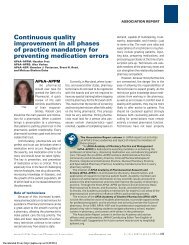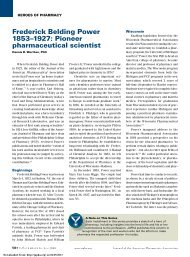Downloaded - Journal of American Pharmacists Association
Downloaded - Journal of American Pharmacists Association
Downloaded - Journal of American Pharmacists Association
Create successful ePaper yourself
Turn your PDF publications into a flip-book with our unique Google optimized e-Paper software.
FEATURE Annual Meeting Abstracts 2004<br />
will be assessed using chi square analysis. Interval<br />
data will be analyzed using means, standard deviations,<br />
and Student’s t test for paired data.<br />
Results: Screenings are ongoing; the following<br />
data are aggregate. A comparison by setting will be<br />
presented. A total <strong>of</strong> 92 patients (81 CP, 11 PCC)<br />
have been screened, including 88 (96%) women.<br />
Mean (± SD) age is 48 ± 18 years. Patients average<br />
2.7 ± 1.6 risk factors for osteoporosis, and the mean<br />
(± SD) T score is –0.2 ± 1. A total <strong>of</strong> 221 osteoporosis-specific<br />
recommendations have been made: 67 to<br />
increase calcium, 53 to increase vitamin D, 50 to initiate<br />
or increase weight-bearing exercise, 25 to<br />
obtain a diagnostic scan, 6 to reduce modifiable risk<br />
factors, and 20 miscellaneous. Some 54 (59%)<br />
patients returned evaluable surveys, and 16 <strong>of</strong> 37<br />
(43%) responders had followed calcium recommendations,<br />
and 14 <strong>of</strong> 30 (47%) responders followed the<br />
exercise recommendations. On a scale <strong>of</strong> 1 to 10 (1<br />
= very dissatisfied; 10 = very satisfied), patients<br />
rated the screening service at 8.9 ± 2.5, and all<br />
reported that they would recommend the service to a<br />
friend.<br />
Conclusions: Preliminary results indicate patients<br />
do change behavior, are highly satisfied with osteoporosis<br />
screenings conducted by pharmacists in the<br />
community setting and in nondispensing pharmaceutical<br />
care centers, and would recommend the service<br />
to others.<br />
57—COMPARING THE RISK FOR OSTEO-<br />
POROSIS IN HISPANIC AND CAUCASIAN<br />
WOMEN BASED UPON BONE DENSITY<br />
MEASUREMENTS OBTAINED FROM COM-<br />
MUNITY HEALTH SCREENINGS. Alvarez G,<br />
Nova-Southeastern University, Marsh W, Hunter T,<br />
Droege M, Nova Southeastern University. E-mail:<br />
galvarez@nova.edu<br />
Objective: The objective <strong>of</strong> this study was to<br />
determine whether Caucasian–Hispanics are at a significantly<br />
lower risk than are non-Hispanic<br />
Caucasians for development <strong>of</strong> osteoporosis.<br />
Osteoporosis, a debilitating bone disease defined by<br />
decreased mass and altered bone micro-architecture,<br />
results in increased bone fragility and increased risk<br />
<strong>of</strong> fracture. The World Health Organization defines<br />
osteoporosis as a T score 2.5 standard deviations<br />
below the mean for young adult controls. All<br />
women, regardless <strong>of</strong> race, are at risk <strong>of</strong> developing<br />
osteoporosis; however, Caucasian or Asian women<br />
are commonly considered being at higher risk.<br />
Hispanics in the United States are <strong>of</strong> Mexican,<br />
Puerto Rican, Cuban, Dominican Republic, Central<br />
<strong>American</strong>, or South <strong>American</strong> descent; many<br />
Hispanics in South Florida are <strong>of</strong> Caucasian heritage.<br />
Whether osteoporosis risk differs based upon<br />
heritage within the Hispanic population is unknown.<br />
If health care providers mistakenly believe that some<br />
are not at risk for this disease, opportunities for<br />
appropriate prevention may be forfeited.<br />
Methods: Bone density measurements were used<br />
to assess the osteoporosis risk in 627 men and<br />
women in South Florida. Each subject self-reported<br />
gender, age, and race. Bone density measurements<br />
were obtained using a Hologic Sahara Bone<br />
Sonometer and T scores were calculated. Data are<br />
presented for 353 (209 Hispanic and 144 Caucasian)<br />
women over the age <strong>of</strong> 55.<br />
Results: The overall mean T score for the group<br />
was –1.229 with a standard deviation <strong>of</strong> 1.0385. The<br />
mean T score obtained for Hispanic women was<br />
–1.194, compared with –1.280 for Caucasian<br />
women. An independent Student’s t test for paired<br />
data confirmed that there was no statistically significant<br />
difference between the groups (t = 0.76, P =<br />
.47). As expected, the correlation between the<br />
obtained T score and age was negative (r = –.36),<br />
reflecting bone loss with increasing age.<br />
Conclusions: This study indicates that Hispanic<br />
women <strong>of</strong> Caucasian heritage are at equal risk <strong>of</strong><br />
developing osteoporosis as Caucasian women.<br />
58—CONSUMER ATTITUDES TOWARD<br />
THE OVERALL VALUE OF THE PHARMA-<br />
CIST AS A DRUG INFORMATION SOURCE.<br />
Rollins B, Sullivan D, Ohio Northern University. E-<br />
mail: b-rollins@onu.edu<br />
Objective: Consumers consistently view the pharmacist<br />
as one <strong>of</strong> the most trusted and respected pr<strong>of</strong>essionals,<br />
but do they truly view the pharmacist as a<br />
valuable source <strong>of</strong> drug and medical information?<br />
The pharmacist, especially in the community setting,<br />
is the one <strong>of</strong> the most accessible and reliable sources<br />
<strong>of</strong> drug information for the consumer. However, are<br />
there barriers preventing consumers from seeking<br />
the pharmacist’s advice? The purpose <strong>of</strong> the study is<br />
to assess consumer attitudes toward the overall value<br />
<strong>of</strong> the pharmacist as a drug information source. The<br />
researchers will attempt to answer the following<br />
research questions: (1) Consumer attitudes toward<br />
the availability and approachability <strong>of</strong> the pharmacist;<br />
(2) is the pharmacist seen as a true patient advocate;<br />
(3) who do consumers seek to answer their drug<br />
information questions; and (4) do consumers prefer<br />
written drug information or pharmacist counseling?<br />
The fourth research question is based on the results<br />
<strong>of</strong> a previous study in which consumers slightly to<br />
moderately agreed they would rather have a voluntary<br />
package insert versus personal instruction from<br />
the pharmacist regarding the use <strong>of</strong> a corticosteroid<br />
nasal spray (mean = 4.49 ± 1.268; scale: 1 = strongly<br />
disagree to 6 = strongly agree).<br />
Methods: Consumers were selected for inclusion<br />
in the study from a database <strong>of</strong> Ohio residents<br />
between the ages <strong>of</strong> 18 and 70. A sample size <strong>of</strong><br />
approximately 140 consumers was calculated based<br />
on a priori alpha <strong>of</strong> .05, beta <strong>of</strong> .20, and power <strong>of</strong> .80.<br />
Based on an estimated response rate <strong>of</strong> 35%, 400<br />
consumers will be randomly selected through simple<br />
random sampling from this database. The survey<br />
instrument is a self-administered mailed questionnaire.<br />
The questionnaire uses approximately 35 questions<br />
to assess the four research questions. Data will<br />
be analyzed using descriptive statistics and Student’s<br />
t test for paired data. Demographic differences (gender,<br />
age, education level) will also be analyzed.<br />
Results: Data collection ongoing.<br />
Conclusions: Data collection ongoing.<br />
59—CREATING THE CAPACITY FOR<br />
CASE MANAGEMENT IN A COMMUNITY<br />
PHARMACY. McDonough R, Doucette W,<br />
Musick J, Klepser D, McCarthy R, University <strong>of</strong><br />
Iowa. E-mail: randal-mcdonough@uiowa.edu<br />
Objective: Main at Locust Pharmacy Clinic<br />
developed and implemented a process to provide<br />
case management services for the Iowa Medicaid<br />
Pharmaceutical Case Management (PCM) Program.<br />
The objective <strong>of</strong> this report is to describe the patient<br />
care processes and forms that were developed to provide<br />
case management services for eligible patients.<br />
Methods: Design: A descriptive overview <strong>of</strong> the<br />
patient care processes developed and implemented at<br />
the pharmacy to provide efficient and effective care<br />
to eligible Medicaid patients. Setting: An independent<br />
community pharmacy Patients: Medicaid recipients<br />
who were taking four or more long-term oral<br />
medications and had one or more <strong>of</strong> the 12 disease<br />
states that are costly to Iowa Medicaid (heart failure,<br />
coronary artery disease, diabetes mellitus, hypertension,<br />
hyperlipidemia, asthma, depression, atrial fibrillation,<br />
osteoarthritis, gastroesophageal reflux disease,<br />
peptic ulcer disease, and chronic obstructive<br />
pulmonary disease) Data Collection: A description<br />
<strong>of</strong> the patient care process that evolved over the 2-<br />
year period is provided. Patient care forms and<br />
physician communication tools that were developed<br />
to improve the efficiencies <strong>of</strong> the patient care process<br />
are discussed and shared. The number <strong>of</strong><br />
patients enrolled, the number <strong>of</strong> drug therapy problems<br />
found, and the physician response to pharmacists’<br />
recommendations is described. Analysis Plan:<br />
Description <strong>of</strong> the patient care process<br />
Results: Over a 2-year period, 259 patients met<br />
eligibility criteria. The clinic enrolled 153 patients<br />
into the program. Patient care processes were developed<br />
and patient care forms created. Communication<br />
forms were developed that improved the physician<br />
response rate to the pharmacists’ recommendations.<br />
<strong>Pharmacists</strong> found 901 drug therapy problems over<br />
the 2-year period. Physicians responded to pharmacists’<br />
recommendations approximately 60% <strong>of</strong> the<br />
time. In 48% <strong>of</strong> the cases, pharmacists’ recommendations<br />
led to a documented change in patients’ medications.<br />
Conclusions: <strong>Pharmacists</strong> at Main at Locust<br />
Pharmacy Clinic were successful in developing and<br />
implementing case management services in a patient<br />
population considered at high risk for drug therapy<br />
problems.<br />
60—DETERMINING THE EFFECT OF<br />
MEDIA RELATIONS ON PHARMACISTS.<br />
Ferreri S, University <strong>of</strong> North Carolina at Chapel<br />
Hill, C<strong>of</strong>fey C, Mercer University Southern School<br />
<strong>of</strong> Pharmacy. E-mail: ferreri@E-mail.unc.edu<br />
Objective: (1) To address if pharmacists have<br />
interacted with media. (2) Report if pharmacists<br />
receive communication or media training. (3)<br />
Identify how pharmacists could improve their interaction<br />
with the media.<br />
Methods: The members <strong>of</strong> the OTC Media<br />
Advisors network were chosen based on the criteria<br />
<strong>of</strong> knowledge <strong>of</strong> OTC medications, availability to<br />
240 <strong>Journal</strong> <strong>of</strong> the <strong>American</strong> <strong>Pharmacists</strong> <strong>Association</strong> www.japha.org March/April 2004 Vol. 44, No. 2<br />
<strong>Downloaded</strong> From: http://japha.org/ on 01/25/2014


